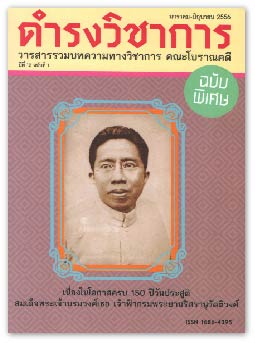THE EDICT OF THE PANCHA-ANTARADHAN AND THE ESTABLISHMENT OF THE PAGODA IN THE TOWN OF NAKORNCHUM BY KING MAHADHARMARAJA - LITHAI OF SUKHOTHAI IN B.E. 1900
Keywords:
พระบรมธาตุ, เมืองนครชุม, ปัญจอันตรธานAbstract
The objective of this paper was to search for the purpose of the existence of Pancha – Antaradhan, a concept devised by King Mahadharmmaraja – Lithai of Sukhothai through the stablishment of an inscription together with a pagoda that contains the true holy relic of Lord Buddha and also the planting of a holy papal tree (both came from Sri Lanka) in the town of Nakorn – Chum (on the Ping riverside, opposite the town of Kamphangphet) in B.E. 1900.
The result of this study provides us with information about the area of Kamphaengphet Province which shows that the area has very fertile land and that the area contains a high percentage of minerals, especially iron ore. Moreover, the town of Kamphangphet as one of the most important commercial towns in the Lower Ping and Wang basin and the upper Chao Praya basin and that it dominated the entire northwestern trade Route in Thailand. Therefore the town of Kamphaengphet and its surrounding area was certainly one of the most important and valuable regions in the Kingdom of Sukhothai and that King Mahadharmaraja-Lithai had a strong desire to keep this region in his kingdom
As such, King Mahadharmaraja-Lithai himself came to the town of Nakorn – Chum to establish the pagoda containing the true holy relic of Lord Buddha and also to plant a holy papal tree (both from Sri Lanka) together with an inscription for an announcement of his majestic, merit and also his legitimacy as the one true lord of this region and Kingdom, inherited from King Ramkhamhaeng the Great. So as such, all of elites and citizens in this region had to acknowledge him as a “Dharmikaraja” who brought peace and prosperity to this land. Finally, such an announcement, could permanently maintain his authority in this region. All of the people in this region certainly respected him as their savior. So this land remained in the Sukhothai Kingdom without the need for war or without being occupied.
References
กรมศิลปากร. “ศิลาจารึกนครชุม.” ใน ประชุมพงศาวดารฉบับกาญจนาภิเษก เล่ม 3. กรุงเทพฯ: กองวรรณกรรมและประวัติศาสตร์ กรมศิลปากร, 2542.
กรมศิลปากร. “จารึกกฎหมายลักษณะโจร.” ใน ประชุมจารึก ภาคที่ 8 จารึกสุโขทัย. กรุงเทพฯ: กรมศิลปากร, 2548.
ประเสริฐ ณ นคร.งานจารึกและประวัติศาสตร์ของประเสริฐ ณ นคร. นครปฐม: โรงพิมพ์ศูนย์ส่งเสริมและฝึกอบรมการเกษตรแห่งชาติมก. กําาแพงแสน, 2534.
ประเสริฐ ณ นคร, ปวงคํา ตุ้ยเขียว. ตํานานมูลศาสนา เชียงใหม่ เชียงตุง.กรุงเทพฯ: สมาคมประวัติศาสตร์ ในพระราชูปถัมภ์ สมเด็จพระเทพรัตนราชสุดาฯ สยามบรมราชกุมารี, 2537.
พิเศษ เจียจันทร์พงษ์. ศาสนาและการเมืองในประวัติศาสตร์สุโขทัย–อยุธยา. กรุงเทพฯ: มติชน, 2545.
รัตนปัญญาเถระ. ชินกาลมาลีปกรณ์. ร.ต.ท. แสง มนวิทูร แปล. กรุงเทพฯ: โรงพิมพ์มหาจุฬาลงกรณ์ราชวิทยาลัย, 2540.
วันชัย จันทร์ฉาย. แผนการใช้ที่ดินจังหวัดกําาแพงเพชร. กรุงเทพฯ: กรมพัฒนาที่ดิน กระทรวงเกษตรและสหกรณ์, 2533.
สุจิตต์ วงษ์เทศ. แคว้นสุโขทัย รัฐในอุดมคติ. กรุงเทพฯ: มติชน, 2539.
สุภาพรรณ ณ บางช้าง. ประวัติวรรณคดีบาลีในอินเดียและลังกา. กรุงเทพฯ:จุฬาลงกรณ์มหาวิทยาลัย, 2526.
Downloads
Issue
Section
License
บทความนี้เป็นผลงานของข้าพเจ้าแต่เพียงผู้เดียว และ/หรือเป็นผลงานของข้าพเจ้าและผู้ร่วมงาน ตามชื่อที่ระบุในบทความจริง และเป็นผลงานที่มิได้ถูกนำเสนอหรือตีพิมพ์ที่ใดมาก่อน





